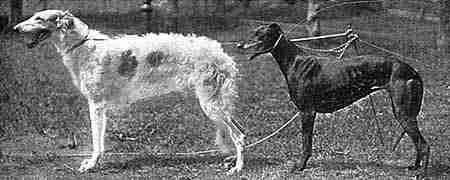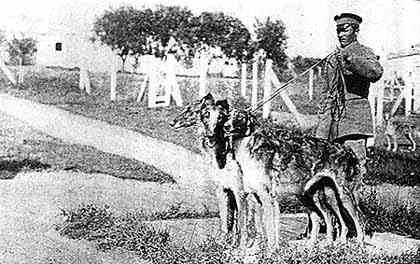
This photograph
of a Russian wolfhound and a greyhound shows the
different
characteristics of the two breeds.

This photograph
of a Russian wolfhound and a greyhound shows the
different
characteristics of the two breeds.
fight between a dog or dogs and a wolf. It means training. In the kennels of the Czar nearly a score of men are kept for the purpose of attending to and training the young candidates, of which there are sometimes half a hundred, in addition to as many developed dogs; and in the kennels of the nobility and landed proprietors the same method is carried out and the dogs are properly entered at the game. Of course it takes a dog of high courage to do the work, for ther must be no faltering. In other words, the dog must be game and "hard bitten," as we say ofa terrier; and such dogs are somewhat too ''scrappy" for family use. American purchasers have no occasion to worry about that, however, for as this high courage is the result of education and encouragement, without it they are docile and obedient and fit companions for the ladies of the house, a role which they are pre-eminently fitted to fill by reason of their handsome and unique appearance.
When two hounds are liberated they range up on either side, each getting a similar hold behind the ear. The art in this case is to slip two hounds perfectly matched in speed.
An English officer who served for some time in the Russian service, and who had an opportunity to see the Czar's wolfhounds in the field, mentions particularly a dog named Dimitri which was slipped at a large black wolf, which he very speedily caught. Over they went as usual, but when the dust had cleared away Dimitri was holding the wolf ready for the chasseur to muzzle.* At dinner that evening the question of whether a borani could face and pin a wolf single handed was discussed, with the result that on the following morn ing the largest wolf was liberated in an enclosed yard and Dimitri sent in at him. The wolf at once flew at the dog, and over and ox-er they went; but when they ceased struggling Dimitri had the neck-hold and there was not a mark on him in return.
The borzoi is perhaps best described to the unitiated by saying that he is a tall, long- coated greyhound, very narrow in body, with a long, narrow head, deep chest, arched back and well cut up in the loin. This, however, is only the outlined rough sketch, and there is a good deal more before you have the finished picture. The head is exceedingly long and narrow, the muzzle apparently being carried out to an excessive length. There is no stop stop between the eyes, but immediately above them there is. an angle, the line of skull not being a continuation of the line of the muzzle. It must not be too pronounced an angle, neither must there be too much of an indication of a Roman nose. The skull is carried well out to the occiput, which should not be too prominent, however. While the profile outline of the skull is straight, viewed from the front, it should not he flat but oval, thus adding to the appearance of narrowness. The eves even with this formation of skull, must not be set obliquely, and they are therefore rather close together, are almond shaped and should be dark in color. The ears are set well back on the head and are thrown back like a greyhound's; the smaller and thinner in leather they are so much the better, as nothing detracts so much from the dog's quality as a heavy lop ear. The Russians seem to fancy the ear being ''tulip," erect, when thrown forward; but, while there is no great objection to that, yet the semi-erect, with the tip falling forward, is a more symmetrical form and will probably be preferred in this country.

At Perchina. A tan and
white wolf' team.
4.
Copyright Rey and Yvonne McGehee 2000.